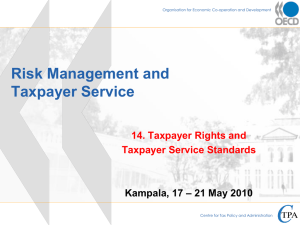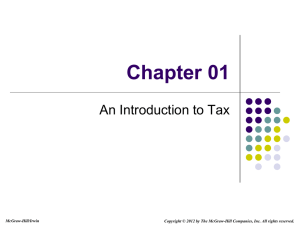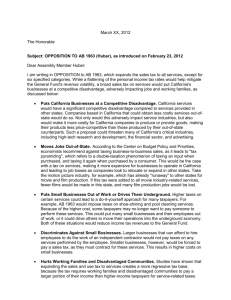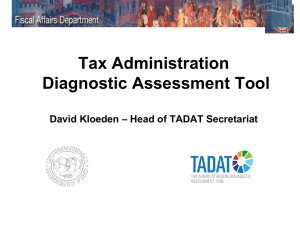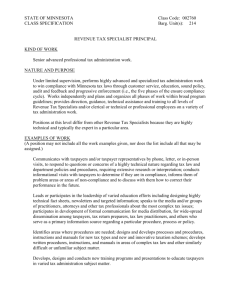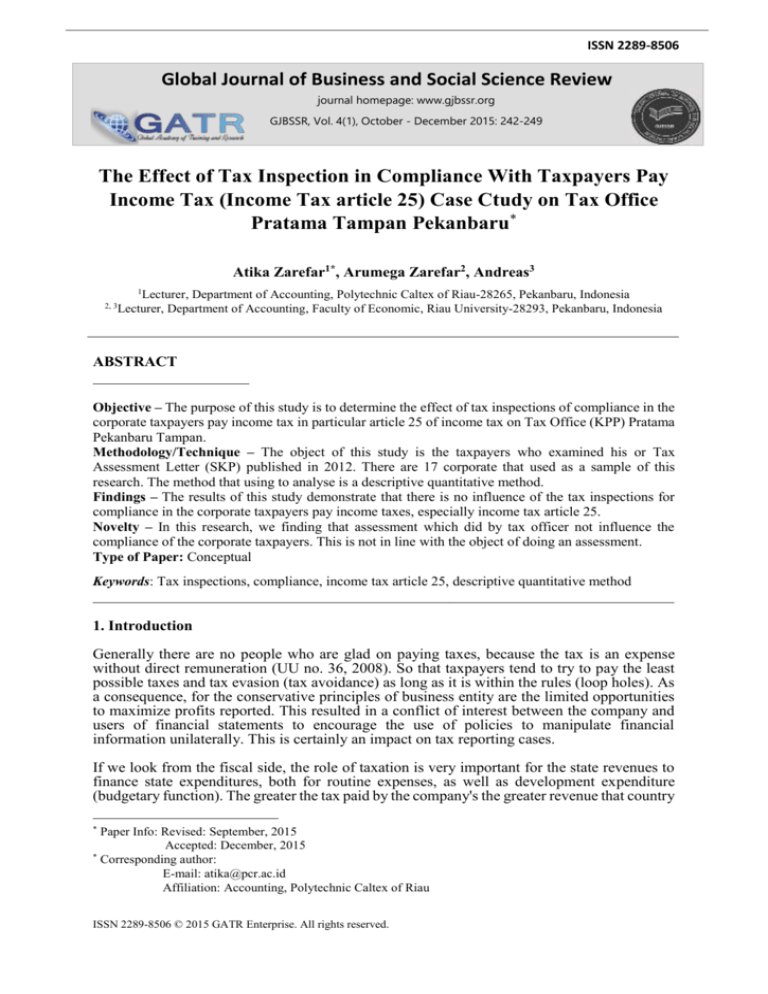
ISSN 2289-8506
Global Journal of Business and Social Science Review
journal homepage: www.gjbssr.org
GJBSSR, Vol. 4(1), October - December 2015: 242-249
The Effect of Tax Inspection in Compliance With Taxpayers Pay
Income Tax (Income Tax article 25) Case Ctudy on Tax Office
Pratama Tampan Pekanbaru*
Atika Zarefar1*, Arumega Zarefar2, Andreas3
1
Lecturer, Department of Accounting, Polytechnic Caltex of Riau-28265, Pekanbaru, Indonesia
Lecturer, Department of Accounting, Faculty of Economic, Riau University-28293, Pekanbaru, Indonesia
2, 3
ABSTRACT
Objective – The purpose of this study is to determine the effect of tax inspections of compliance in the
corporate taxpayers pay income tax in particular article 25 of income tax on Tax Office (KPP) Pratama
Pekanbaru Tampan.
Methodology/Technique – The object of this study is the taxpayers who examined his or Tax
Assessment Letter (SKP) published in 2012. There are 17 corporate that used as a sample of this
research. The method that using to analyse is a descriptive quantitative method.
Findings – The results of this study demonstrate that there is no influence of the tax inspections for
compliance in the corporate taxpayers pay income taxes, especially income tax article 25.
Novelty – In this research, we finding that assessment which did by tax officer not influence the
compliance of the corporate taxpayers. This is not in line with the object of doing an assessment.
Type of Paper: Conceptual
Keywords: Tax inspections, compliance, income tax article 25, descriptive quantitative method
__________________________________________________________________________________
1. Introduction
Generally there are no people who are glad on paying taxes, because the tax is an expense
without direct remuneration (UU no. 36, 2008). So that taxpayers tend to try to pay the least
possible taxes and tax evasion (tax avoidance) as long as it is within the rules (loop holes). As
a consequence, for the conservative principles of business entity are the limited opportunities
to maximize profits reported. This resulted in a conflict of interest between the company and
users of financial statements to encourage the use of policies to manipulate financial
information unilaterally. This is certainly an impact on tax reporting cases.
If we look from the fiscal side, the role of taxation is very important for the state revenues to
finance state expenditures, both for routine expenses, as well as development expenditure
(budgetary function). The greater the tax paid by the company's the greater revenue that country
*
Paper Info: Revised: September, 2015
Accepted: December, 2015
*
Corresponding author:
E-mail: atika@pcr.ac.id
Affiliation: Accounting, Polytechnic Caltex of Riau
ISSN 2289-8506 © 2015 GATR Enterprise. All rights reserved.
Atika Zarefar, Arumega Zarefar and Andreas
can receive. Because of the importance of the contribution of taxes in state revenue, the
taxpayer has a role and a great responsibility in implementing the provisions of the Law of
Taxation with all its implementing regulations. In order to improve taxpayer compliance (WP)
as part of efforts to secure tax revenues and refer to the Strategic Plan of the Directorate General
of Taxation (DGT) 2010-2014 and the achievement of Key Performance Indicators (KPI) in
2012, DJP need to optimize the delivery of the Notification letter (SPT) through the submission
of tax return compliance policies in 2012. One of them is to establish the size of the submission
compliance ratio of notification letter (SPT) Income Tax (Annual Income Tax) in 2012 of at
least 62.50%. (DGT, 2012).
In the present study, the researchers chose to study the case in Tax Office (KPP) Pratama
Pekanbaru Tampan looking and focused on the corporate taxpayers. The reason the researchers
chose to study the case in Tax Office Pratama Pekanbaru Tampan is as Tax Office Pratama
Pekanbaru Tampan is the Tax Office which operates most closely with researchers. While there
are two reasons researchers focused on company taxpayers, first because the company income
tax including a large contributor of tax revenue inTax Office Pratama Pekanbaru Tampan. It
can be seen from the greater contribution of income tax paid by the company compared to the
income tax paid by individuals. The second reason is because of a smaller percentage of income
tax revenue attainment from company taxpayers (Tax Article 25) when compared to the
percentage achievement of individual income tax revenue. It can be seen from table 1 below.
Tabel 1. Net Tax Revenue Tax Office Pratama Pekanbaru Tampan Per 31 December 2011
Plan 2011
(APBNP) (Rp.)
Net realization
(Rp.)
Achievement
(%)
a.5. Income tax article 25/29
Individual
7,350,450,565
13,653,914,289
185.76%
a.6. Income tax article 25/29
Institution
76,277,636,776
41,234,356,519
54.06%
Types of tax
A.
Income Tax
Source: Data MPN 10 January 2012
From the above table, it demonstrates that the receipt of the company taxpayer (Article 25/29)
is a large reception at the Tax Office Pratama Pekanbaru Tampan, but instead, the percentage
of realization is far below its planning. The percentage of tax revenue from corporate taxpayers
(Article 25/29) in 2011 only reached 54.06% or below half of planning revenues in 2011.
2. Review of Literature
2.1 Income Tax article 25
Income Tax (abbreviated as PPh) imposed on the taxpayer in a given period called a tax year.
Based on this, the calculation and income tax calculation is done once a year as outlined in the
annual tax return. Because the income tax calculation is done once a year, then this calculation
should be done after one year of the end so that all the data of income in one year is known. In
this way, the amount of income tax payable of course that must be paid will be known when a
tax year has ended. In order for the tax payment is not done at once which would be
burdensome, then made the mechanism of tax payment in advance or repayment every month.
Instalment payments or instalment is called the Income Tax Article 25 (PPh article 25).
(Mardiasmo, 2008).
The instalment of Income Tax Article 25 shall be calculated in accordance with the provisions.
In general, how to calculate the income tax based on the Article 25 Data SPT previous year.
That is, we assume that earnings this year equal to the income the previous year. Of course
there will be a difference with the actual condition when the tax year is now over. The
243 | P a g e
GJBSSR, Vol. 4(1), October - December 2015: 245-249
Atika Zarefar, Arumega Zarefar and Andreas
difference is exactly what we pay a year-end tax deficiency. Underpayment end of the year
usually called Tax Article 29. If the difference indicates an overpayment that called Tax Article
28, then this condition is called Taxpayers requesting refunds or tax overpayment that has been
done, (Gunadi, 2009).
In general, this tax installment amounts payable based to the Income Tax Income Tax SPT last
year reduced by tax credits Income Tax Articles 21, 22, 23 and 24, divided by 12, or the number
of months in the part of the tax year.
For example, SPT 2007 showed the following data:
Income tax payable
50,000,000
Income Tax Credit Articles 21, 22, 23 and 24
35,000,000
Thus, article 25, 2008 to be paid each month is as follows:
Income tax payable
50,000,000
Income Tax Credit Articles 21, 22, 23 and 24
35,000,000
Difference
15,000,000
Tax Article 25 = 15,000,000: 12 =
1,250,000
Income Tax Article 25 for the months before the deadline for submission of their annual tax
return is equal to the income tax under Article 25, the last month of the tax year ago. If the tax
year is the calendar year (January to December), it is a few months before the deadline for
submission of their annual tax return is January and February. Thus, Tax Article 25 in January
and February 2008 is equal to Income Tax Article 25 December 2007, (Gunadi, 2009).
If in the current year issued Tax Assessment Letter (SKP) for the preceding taxable year, then
the amount of tax installment is recalculated based SKP and apply from the following month
after the publication of SKP.
2.2 Tax Compliance
According to Simon James et al cited by Gunadi (2005), the idea of tax compliance is the
taxpayer has a willingness to meet their tax obligations in accordance with the applicable rules
without the need for the holding of the tax audit, investigation thorough, warnings, or even
threats and sanctions legal or administrative.
A notification letter is a letter by the taxpayer is used to report the calculation and/ or payment
of taxes, taxes and/ or non-taxable income and/ or assets and liabilities in accordance with the
provisions of tax legislation. (Gunadi, 2005).
2.2.1 Types of Tax:
1. Notification Letter – Period (SPT-Masa)
Notification Letter-period is a letter by the taxpayer is used to report the calculation
and payment of the tax payable or in a tax period or time.
244 | P a g e
GJBSSR, Vol. 4(1), October - December 2015: 245-249
Atika Zarefar, Arumega Zarefar and Andreas
2. Notification Letter – Annual (SPT-Tahunan)
Notification Letter- Annual is a letter by the taxpayer is used to report the calculation
and payment of tax payable in a tax year.
The deadline for submission of notification letter is:
1. For the Notification Letter – Period, no later than 20 days after the end of the tax
period, Unless the deadline for submission of SPT - Future income tax Article 22
Imports that is 14 days after the end of the tax period.
2. For the Notification Letter of Annual Income Tax Return individual taxpayer, no later
than three months after the end of the tax year.
3. For the Notification Letter of Annual Income Tax corporate taxpayer, at the latest four
months after the end of the tax year.
Notification Letter is considered not submitted if:
1. Notification Letter is not signed.
2. Notification Letter is not fully enclosed information and / or documents that have been
set.
3. Notification Letter of the claimed overpayment delivered after three years after the end
of the tax period, part of the fiscal year or fiscal year, and the taxpayer has been
reprimanded in writing, or
4. Notification Letter submitted after the Directorate General of Taxation checks or
issuing tax assessments.
2.3 Tax Audit
Tax audits is a series of activities to seek, collect, process data or other information to verify
compliance fulfilment of tax obligations and for other purposes in order to implement the
provisions of the tax legislation. (Mardiasmo, 2008)
Compliance testing compliance with tax obligations:
a. Notification letter (SPT) overpayments and losses.
b. Notification letter (SPT) no or late delivered.
c. Notification letter (SPT) meets specified criteria the Director General of Tax to be
examined.
d. indications not fulfilled obligations other than the obligations to the letter.
e. Indications of unfulfilled obligations other than the obligations to the letter.
2. Another objective, namely:
a. Giving Tax identification number (TIN).
b. Elimination TIN.
c. Inauguration PKP in position and confirmation or revocation of the inauguration of PKP.
245 | P a g e
GJBSSR, Vol. 4(1), October - December 2015: 245-249
Atika Zarefar, Arumega Zarefar and Andreas
d. Taxpayers file an objection or appeal.
e. Collecting material for the preparation of Net Income Calculation Norm.
f. Matching the data or information tools.
g. Determination of the taxpayer located in a remote place.
h. The determination of one or more places subjects to VAT.
3. Research Methodology
3.1 Research Object
The population in this study are all Tax Assessment Letter (SKP) of company taxpayers issued
by the Tax Office Pratama Pekanbaru Tampan in 2010, and the compliance of company
taxpayers one year before and one year after the tax audit conducted by the Tax Office Pratama
Pekanbaru Tampan in 2010.
3.2 Type and Source of Data
The source of data used in the study come from internal sources and the secondary data.
Secondary data such as tax compliance reports and results of tax assessment letter of company
taxpayers published in 2010 in Tax Office Pratama Pekanbaru Tampan.
3.3 Data Collection Methods
Data collection methods used by researchers are as follows:
3.3.1 Documentation
Researchers collected data by writing the documents related to tax compliance board and other
data such as data Tax assessment letter of company taxpayers, published in 2010, well an
assessment letter on tax underpayment (SKPKB), an assessment letter on tax underpayment
extra (SKPKBT), an assessment letter on tax overpayment (SKPLB), or an assessment letter
on tax nil (SKPN) required in this study.
3.3.2 Literature study
Literature study is conducted with the aim to obtain a theoretical basis through literature, books,
reports, lecture notes, articles, papers, journals, and other sources that are relevant in
connection with the issues discussed related to the existing problems and useful in this thesis
for the resolution.
3.4 Operational Definitions
3.4.1 Tax Audit
Tax audit is judging by the number of Tax Assessment Letter (SKP) of company taxpayers
issued by Tax Office Pratama Pekanbaru Tampan in 2010. Tax Assessment Letter (SKP)
published consisted of an assessment letter on tax underpayment (SKPKB), an assessment
letter on tax underpayment extra (SKPKBT), an assessment letter on tax overpayment
(SKPLB), and an assessment letter on tax nil (SKPN).
246 | P a g e
GJBSSR, Vol. 4(1), October - December 2015: 245-249
Atika Zarefar, Arumega Zarefar and Andreas
3.4.2 Compliance of company taxpayers
Compliance of corporate taxpayers can be seen from the data of compliance of company
taxpayers for the type of income tax article 25 (PPh article 25), which can be seen from the
data of tax payment slip (SSP) Tax Article 25 accepted on Tax Office Pratama Pekanbaru
Tampan one year before and one year after the tax audit in 2010.
3.5 Data Analysis Method
The research is quantitative descriptive. Quantitative research is done by finding the percentage
of compliance of company taxpayers on a monthly basis over a period of 2 years, i.e. one year
before the examination and one year after tests carried out in 2010 by Tax Office Pratama
Pekanbaru Tampan. Then the percentage obtained, the researchers compared the percentage of
compliance obtained a year before and after the tax audit, if there are significant changes to the
compliance of payment/ reporting of income tax paid by the Article 25 (PPh article 25) of
company taxpayers on Tax Office Pratama Pekanbaru Tampan with a hearing in 2010.
Acknowledgements
After the researchers calculate percent of compliance each corporate, data that researchers found is as
follows:
1. The level of tax compliance in paying income tax article 25 in May decreased by 11.5%%
(47 %% - 35.3%) after the examination.
2. The level of tax compliance in paying income tax article 25 in June decreased by 23.3%
(58.8% - 35.5%) after the examination.
3. The level of tax compliance in paying income tax article 25 in July decreased by 47.1%
(76.5% - 29.4%) after the examination.
4. The level of tax compliance in paying income tax article 25 in August decreased by 29.4%
(70.6% - 41.2%) after the examination.
5. The level of tax compliance in paying income tax article 25 in September decreased by
23.5% (64.7% - 41.2%) after the examination.
6. The level of tax compliance in paying income tax article 25 in October decreased by
29.4% (58.8% - 29.4%) after the examination.
7. The level of tax compliance in paying income tax article 25 in November decreased by
23.6% (53% - 29.4%) after the examination.
8. The level of tax compliance in paying income tax article 25 in December decreased by
35.3% (64.7% - 29.4%) after the examination.
9. The level of tax compliance in paying income tax article 25 in January increased by 23.6%
(53% - 29.4%) after the examination.
10. The level of taxpayer compliance in paying income tax article 25 in February increased
by 29.4% (47% - 17.6%) after the examination.
11. The level of tax compliance in paying income tax article 25 in March increased by 41.2%
(53% - 11.8%) after the examination.
12. The level of tax compliance in paying income tax article 25 in April increased by 23.5%
(47% - 23.5%) after the examination.
247 | P a g e
GJBSSR, Vol. 4(1), October - December 2015: 245-249
Atika Zarefar, Arumega Zarefar and Andreas
Based on the results of data analysis in the previous discussion, it can be concluded that the tax
period May to December levels of compliance of taxpayer company after the tax audit has
declined when compared with the level of compliance before the tax audit in 2010, while the
tax period January to April the level of compliance of taxpayer company after tax audit have
greater than before when compared to the level of compliance before the tax audit in 2010. But
the overall level of compliance with corporate taxpayers decreased by 8.8% from 48% in 2009
to 39.2% in 2011.
As a conclusion, there is no significant influence of the tax audit to the level of compliance tax
in Tax Office Pratama Pekanbaru Tampan.
References
Santoso, Waluyo. (2008). Analisis Risiko Ketidakpatuhan Wajib Pajak Sebagai Dasar Peningkatan
Kepatuhan Wajib Pajak. Jurnal Keuangan Publik Vol. 5, No. 1, 85-137.
Gunadi. (2005). Fungsi Pemeriksaan Terhadap Peningkatan Kepatuhan Pajak. Jurnal Perpajakan
Indonesia. Vol 4, 5: 4--9.
Gunadi. (2009). Akuntansi Pajak. Jakarta: PT Gramedia.
Ilyas, Wiryawan B.,dan Richard Burton. (2001). Hukum Pajak. Jakarta : Salemba Empat.
Mardiasmo. (2008). Perpajakan. Yogyakarta: Penerbit Andi.
Sekaran, Uma. (2006). Research Methods For Business (Buku 1 Edisi 14), Jakarta : Salemba Empat.
Sekaran, Uma. (2006). Research Methods For Business (Buku 2 Edisi 14), Jakarta : Salemba Empat.
Keputusan Direktur Jenderal Pajak Nomor Kep-537/PJ./2000 tanggal 29 Desember 2000.
Keputusan Menteri Keuangan Nomor 545/KMK.04/2000 Tentang Tata Cara Pemeriksaan Pajak
sebagaimana telah diubah dengan Peraturan Menteri Keuangan Republik Indonesia Nomor
123/PMK.03/2006.
Peraturan Menteri Keuangan Nomor 208/PMK.03/2009, Tentang Penghitungan Besarnya Angsuran
Pajak Penghasilan Dalam Tahun Pajak Berjalan Yang Harus Dibayar Sendiri Oleh Wajib Pajak
Baru, Bank, Sewa Guna Usaha Dengan Hak Opsi, Badan Usaha Milik Negara, Badan Usaha
Milik Daerah Dan Wajib Pajak Lainnya Termasuk Wajib Pajak Orang Pribadi Pengusaha
Tertentu.
Surat Edaran Dirjen Pajak No. SE-06/PJ/2012 Tentang Target Rasio Kepatuhan Penyampaian Surat
Pemberitahuan Pada Tahun 2012.
Undang-undang No. 28 Tahun 2007 Tentang Ketentuan Umum dan Tata Cara Perpajakan.
Undang-undang No.36 tahun 2008 Tentang Perubahan Keempat atas Undang-Undang Nomor Tahun
1983 tentang Pajak Penghasilan.
Rini, Indah. 2007. Pengaruh Pemeriksaan Pajak terhadap Kepatuhan Wajib Pajak Memenuhi
Kewajiban Perpajakan pada KPP Jakarta Kebayoran Baru Dua. Tesis Ilmu Sosial Universitas
Indonesia: Jakarta.
248 | P a g e
GJBSSR, Vol. 4(1), October - December 2015: 245-249
Atika Zarefar, Arumega Zarefar and Andreas
Fika Agusti, Asri. (2008). Pengaruh Tingkat Kepatuhan Wajib Pajak Badan terhadap Peningkatan
Penerimaan Pajak yang Dimoderasi oleh Pemeriksaan Pajak pada KPP Pratama. Jurnal pada
Simposium Akuntansi Nasional 12.
Mustikasari, Elia. (2007).
Kajian Empiris Tentang Kepatuhan Wajib Pajak Badan di Perusahaan
Industri Pengolahan di Surabaya, Simposium Nasional Akuntansi X. Makasar.
www.pajak.go.id
249 | P a g e
GJBSSR, Vol. 4(1), October - December 2015: 245-249

